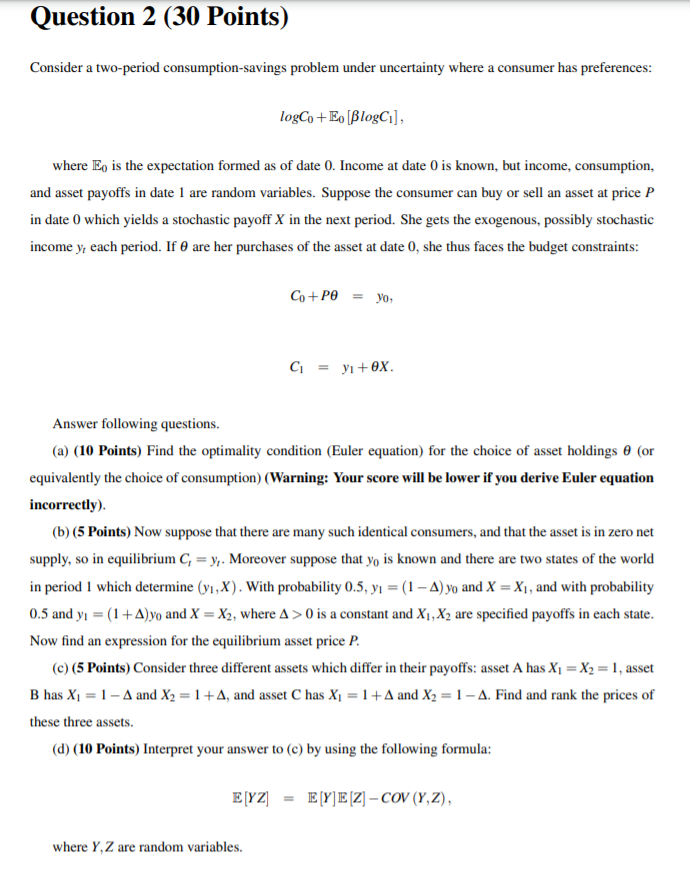Answered step by step
Verified Expert Solution
Question
1 Approved Answer
include equation and calculation steps rather than merely verbal expression Question 2 (30 Points) Consider a two-period consumption-savings problem under uncertainty where a consumer has
include equation and calculation steps rather than merely verbal expression
 Question 2 (30 Points) Consider a two-period consumption-savings problem under uncertainty where a consumer has preferences: logCo + Eo [BlogCi], where Eo is the expectation formed as of date 0. Income at date 0 is known, but income, consumption, and asset payoffs in date 1 are random variables. Suppose the consumer can buy or sell an asset at price P in date 0 which yields a stochastic payoff X in the next period. She gets the exogenous, possibly stochastic income y, each period. If 0 are her purchases of the asset at date 0, she thus faces the budget constraints: Co+0 = yo, CI = yI+OX. Answer following questions. (a) (10 Points) Find the optimality condition (Euler equation) for the choice of asset holdings 0 (or equivalently the choice of consumption) (Warning: Your score will be lower if you derive Euler equation incorrectly). (b) (5 Points) Now suppose that there are many such identical consumers, and that the asset is in zero net supply, so in equilibrium C, = y,. Moreover suppose that yo is known and there are two states of the world in period 1 which determine (y1, X) . With probability 0.5, y1 = (1 -A) yo and X = X1, and with probability 0.5 and y1 = (1 + A)yo and X = X2, where A > 0 is a constant and X1, X2 are specified payoffs in each state. Now find an expression for the equilibrium asset price P. (c) (5 Points) Consider three different assets which differ in their payoffs: asset A has X1 = X2 = 1, asset B has X1 = 1 - A and X2 = 1 + A, and asset C has X1 = 1 + A and X2 = 1 -A. Find and rank the prices of these three assets. (d) (10 Points) Interpret your answer to (c) by using the following formula: E[YZ] = E[Y]E [Z] - COV (Y,Z), where Y, Z are random variables
Question 2 (30 Points) Consider a two-period consumption-savings problem under uncertainty where a consumer has preferences: logCo + Eo [BlogCi], where Eo is the expectation formed as of date 0. Income at date 0 is known, but income, consumption, and asset payoffs in date 1 are random variables. Suppose the consumer can buy or sell an asset at price P in date 0 which yields a stochastic payoff X in the next period. She gets the exogenous, possibly stochastic income y, each period. If 0 are her purchases of the asset at date 0, she thus faces the budget constraints: Co+0 = yo, CI = yI+OX. Answer following questions. (a) (10 Points) Find the optimality condition (Euler equation) for the choice of asset holdings 0 (or equivalently the choice of consumption) (Warning: Your score will be lower if you derive Euler equation incorrectly). (b) (5 Points) Now suppose that there are many such identical consumers, and that the asset is in zero net supply, so in equilibrium C, = y,. Moreover suppose that yo is known and there are two states of the world in period 1 which determine (y1, X) . With probability 0.5, y1 = (1 -A) yo and X = X1, and with probability 0.5 and y1 = (1 + A)yo and X = X2, where A > 0 is a constant and X1, X2 are specified payoffs in each state. Now find an expression for the equilibrium asset price P. (c) (5 Points) Consider three different assets which differ in their payoffs: asset A has X1 = X2 = 1, asset B has X1 = 1 - A and X2 = 1 + A, and asset C has X1 = 1 + A and X2 = 1 -A. Find and rank the prices of these three assets. (d) (10 Points) Interpret your answer to (c) by using the following formula: E[YZ] = E[Y]E [Z] - COV (Y,Z), where Y, Z are random variables Step by Step Solution
There are 3 Steps involved in it
Step: 1

Get Instant Access to Expert-Tailored Solutions
See step-by-step solutions with expert insights and AI powered tools for academic success
Step: 2

Step: 3

Ace Your Homework with AI
Get the answers you need in no time with our AI-driven, step-by-step assistance
Get Started


